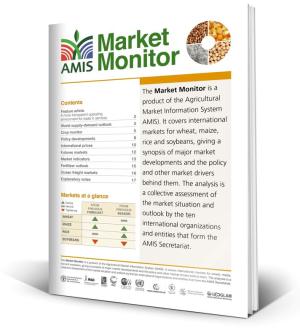Liens externes
The Food Security Portal gratefully acknowledges the European Commission (EC) and the Foreign, Commonwealth & Development Office (FCDO) of the Government of the United Kingdom for their financial support of the Ukraine crisis monitoring.
The crisis in Ukraine threatens global food security at a time when global food markets are already struggling with soaring prices, supply-chain disruptions, and a bumpy recovery from the pandemic. Ukraine and the Russian Federation account for more than 30% of global wheat exports, provide around 12 percent of the globally traded supply of food energy in kilo calories, and are breadbaskets to many food import-dependent developing countries in the Middle East, South Asia, and sub-Saharan Africa. Moreover, Russia is a major producer of fertilizer. Any serious disruption of production and exports from these suppliers will drive up prices further and erode food security for millions of people. If governments respond with export restrictions in an effort to keep domestic food prices in check, the impact on food security will be even higher.
In this context, monitoring the impact of the crisis on food security is key. To that end, this page provides several tools to monitor the situation. Here you can monitor production and stocks, track food export restrictions, check food price volatility, and access resources such as the AMIS Market Monitor.
The AMIS Market Monitor April 2025

Winter wheat crops in the northern hemisphere are breaking dormancy, and maize and soybean harvesting continues in the southern hemisphere. In March 2025, average grains and soybeans export prices exhibited a mostly weaker tone, attributed to easing concerns about crop conditions in major producing countries and geopolitical developments, including escalating international trade tensions. These tensions and trade policy changes create uncertainties for producers, traders, and consumers; risk retaliatory measures; and affect markets with implications for food security. Well-functioning markets are crucial for meeting food demand and ensuring access. As in past episodes of volatility and uncertainty, AMIS strives to maintain and improve transparency and ease access to information, benefiting market actors and policy-makers alike.
Vulnerability to Global Market Shocks V.2: Price Shocks to Major Staple Foods
Vulnerability to Global Market Shocks V.1: Wheat and Fertilizer Price Shocks Caused by Ukraine Crisis
This tool is designed to identify the exposure (vulnerability) of countries to shocks in global markets that may cause supply shortages or price surges in staple foods and key agricultural inputs (like fertilizers) which could erode food security in countries if they are highly dependent on imports of such commodities and/or lack the economic capacity to cushion their vulnerable population against the impacts of those shocks.
Food and Fertilizer Export Restrictions Tracker
The ongoing Russia-Ukraine conflict continues to expose global food security to high uncertainty, exacerbating already soaring food prices stemming from COVID-19-induced supply disruptions and drought-reduced yields. As seen in past global food price crises, some countries have begun restricting food trade with the objective of controlling domestic food inflation. These restrictions can have dire unintended consequences for vulnerable people in food-importing countries, increasing prices and exacerbating food insecurity.
Fertilizer Market Dashboard
The outbreak of the war in Ukraine sent fertilizer prices soaring to all-time highs as prices for natural gas, a key feedstock for nitrogenous fertilizer production, drove production cutbacks and sanctions and export restrictions disrupted exports. These drivers of market turmoil intensified fears of reduced global food production and higher food prices. While global supply continues to rebound and prices abate, risks linger and monitoring market developments remains key.
Production and Stocks Monitoring System
The stock-to-use ratio measures the level of stocks of a commodity relative to its total use, and it is an important indicator of the vulnerability of world food markets to shocks. When stock-to-use ratios are high, more supply is available in inventory, which enables countries to smooth consumption and even out prices in the case of a shock. Low stock-to use ratios increase the severity of price spikes and volatility.
Excessive Food Price Variability Early Warning System
Excessive food price volatility (variability) affects farmers, traders, processors and consumers – and it threatens food security. In the aftermath of the 2007-2008 food price crisis and post-crisis commodity price volatility, the Food Security Portal developed the Excessive Food Price Variability Early Warning System, which identifies periods of excessive price variability (i.e. price variability that exceeds a pre-established threshold). The instrument serves as an early warning system for unusual periods of excessive price variability.
